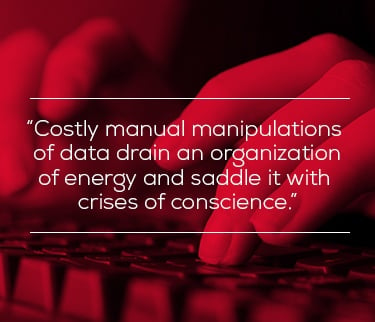 Why front and middle office collaboration is what’s needed now.
Why front and middle office collaboration is what’s needed now.
Never before has there been such a need for collaboration across the asset management enterprise.
Insistent demands for data consistency, speed of risk assessment and performance measurement and efficiency pressures, all combine to require ever-closer working between front and middle offices.
Data consistency
Without a single source of analytics data, achieving consistency in internal management reporting becomes delayed, while workarounds and fixes consume time and resources.
Clients expect consistency in the data they receive and so do regulators. A middle office could spend far too much of its time running from one data source to another gathering and reconciling information that does not match. Yet everyone involved in both the front and middle office can benefit from consistent, accurate and timely analytics data and reporting
Speed
The pace at which larger and larger amounts of market data increases, means the computing power needed to digest it has also grown exponentially. Not only that, the data also needs to be digested quickly because – in order to react and obtain the best possible performance – asset managers require performance and risk data available at their fingertips to inform crucial investment decision making.
{{cta(‘ac6116e0-3f05-4cc8-a5b6-309ed30d8fef’)}}
At the same time changes in transactions, pricing and portfolio positions have to be factored into middle office risk and exposure metrics. Value at risk, and in some cases risk weighted asset models, have to be able to respond to trading and market data and fed back to the front office to ensure trading limits are current at all times. Being able to calculate performance data on an intraday basis greatly enhances the downstream risk analytics.
This vital coordination between risk management and performance measurement can only work properly if both areas of the organization work closely together, sharing the same underlying data set. Indeed the dynamic is self-fulfilling: joined up, consistent working and data breed consistent and credible reporting.
“Many asset managers have, as yet, failed to draw together and coordinate different parts of their organization…”
Cost
Costly manual manipulations of data drain an organization of energy and saddle it with crises of conscience. Employees and management alike become sceptical about the data they are shown. They do not know what to believe. Trying to adapt and reconcile legacy systems represents throwing good money after bad, all the time in the knowledge that another fix will soon be necessary.
Therefore, valuable IT investment dollars have to be spent on forward-looking, competent systems – not squandered on those that will fail and fail again under the demands placed upon them.
As a result, organizations are now recognizing that they need a single performance data source. The data itself has to be able to be processed so as to serve all parts of the middle office and meet both internal and external demands from the front office, regulators and clients. What’s more, systems have to be easily scalable and to be able to handle increasing amounts of data as well as changing demands such as intraday calculations of entire portfolio estates.
In a May 2015 article, Setting up the middle office part 2: turning data into information and insight, Hedgeweek says this:
“Given the daily pressures of aggregating and normalizing data to pass on to the front office, traders, and regulators, and growing requirements to produce customized reports for investors, this challenge with consistency is understandable. As the industry has institutionalized and evolved, the middle office has become a more integral and critical part of a hedge fund’s operations.”
“As such, the need for clean, consistent, accurate and timely data to disseminate, evaluate and act upon to drive change or influence decision-making is essential.”
“With the technology available today,” the article concludes, “managers have the capability to pinpoint specific patterns and trends in large swathes of data and derive insights that previously would have been unobtainable or even unthinkable.”
The thrust of the piece is that much of the challenge with data is to be able to mine it for nuggets of investment wisdom in order achieve success. Having a reservoir of coordinated and consistent performance data is merely the first step.
In a report on the future of tier one investment banks, consultants PWC have highlighted a series of challenges those institutions faced. They conclude that firms face fundamental questions about how to move forward and ask:
- How will they balance mounting regulatory requirements against falling revenues?
- How can they execute their internal front-to-back operating models at a significantly different price point?
- How can they implement cross-divisional initiatives, if they are not positioned to execute transformational changes?
Simply stated, many firms are not prepared to take on cross-divisional initiatives or big bet changes.
The same can be said of many asset managers that have, as yet, failed to draw together and coordinate different parts of their organizations – specifically their front and middle offices – around a central data source that is good for all purposes across the enterprise.
Takeaways:
- Front and middle office collaboration is now imperative.
- This is because of the demands placed upon them by internal and external stakeholders.
- Manual workarounds and aggregation of multiple data sources are hugely resource draining.
- A single, consistent data source is the key.
- Its speed, accuracy and scalability are must-haves.
- Cost containment demands an end to serial and expensive attempts to adapt legacy systems that are inherently not fit for purpose
{{cta(‘bff04473-5d7d-4110-ae71-df16ed720376’)}}